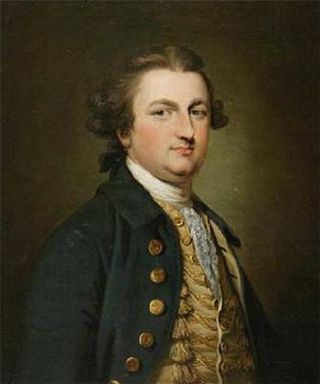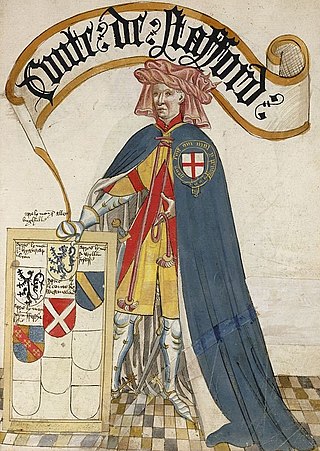Related Research Articles

Earl of Salisbury is a title that has been created several times in English and British history. It has a complex history and is now a subsidiary title to the marquessate of Salisbury.
Earl of Bradford is a title that has been created twice, once in the Peerage of England and once in the Peerage of the United Kingdom. It was first created in 1694 for Francis Newport, 2nd Baron Newport. However, all the Newport titles became extinct on the death of the fourth Earl in 1762. The earldom was revived in 1815 for Orlando Bridgeman, 2nd Baron Bradford. The Bridgeman family had previously succeeded to the Newport estates. The title of the peerage refers to the ancient hundred of Bradford in Shropshire, and not, as might be assumed, to the city of Bradford, Yorkshire, or the town of Bradford-on-Avon in Wiltshire.
The title Earl of Wiltshire is one of the oldest in the Peerage of England, going back to the 12th century. It is currently held by the Marquess of Winchester, and is used as a courtesy title for the eldest son of the marquess.

Henry Somerset, 5th Duke of Beaufort was an English courtier and politician. Styled the Marquess of Worcester from 1746, at his father's death on 28 October 1756, he succeeded him as 5th Duke of Beaufort, 7th Marquess of Worcester, 11th Earl of Worcester, and 13th Baron Herbert.

Earl of Clanricarde is a title that has been created twice in the Peerage of Ireland, first in 1543 and again in 1800. The former creation became extinct in 1916 while the 1800 creation is extant and held by the Marquess of Sligo since 1916.

Arthur Chichester, 3rd Earl of Donegall was an Irish nobleman and soldier.

Ralph de Stafford, 1st Earl of Stafford, 2nd Baron Stafford, KG, of Stafford Castle and Madeley Castle in Staffordshire, was an English nobleman and a notable soldier during the Hundred Years' War against France.

The House of Burgh or Burke was an ancient Anglo-Norman and later Hiberno-Norman aristocratic dynasty which held the earldoms of Kent, Ulster, Clanricarde, and Mayo at various times, provided queens consort of Scotland and Thomond and kings of Britain, and played a prominent role in the Norman invasion of Ireland.

Baron Wake of Liddell is an abeyant title in the Peerage of England. It was created in 1295 for John Wake. It has been in abeyance since 1408.

William Feilding, 3rd Earl of Denbigh, 2nd Earl of Desmond was an English nobleman. He was the son of George Feilding, 1st Earl of Desmond, and his wife, the former Bridget Stanhope, daughter of Sir Michael Stanhope.

Henry Clifford, 2nd Earl of Cumberland was a member of the Clifford family, seated at Skipton Castle from 1310 to 1676. His wife was Lady Eleanor Brandon, a niece of King Henry VIII.
Edmund Stafford, 5th Earl of Stafford and 1st Baron Audley, KG, KB was the son of Hugh de Stafford, 2nd Earl of Stafford, and his wife Philippa de Beauchamp.

Thomas Burgh, 1st Baron Burgh also spelt Borough, KG, 1st Baron Borough of Gainsborough, also de jure 5th Baron Strabolgi and 7th Baron Cobham of Sterborough, was an English peer. In 1513 he was knighted on Flodden Field, where he was one of the King's Spears, a bodyguard of King Henry VIII. He later became Lord Chamberlain to Anne Boleyn. He was also one of the twenty-six Peers summoned to the trial of Anne Boleyn in May 1536.
Margaret de Audley,suo jure2nd Baroness Audley and Countess of Stafford was an English noblewoman. She was the only daughter of Hugh de Audley, 1st Earl of Gloucester, by his wife Lady Margaret de Clare. Her mother was the daughter of Joan of Acre, Princess of England; thus making Margaret a great-granddaughter of King Edward I by his first consort, Eleanor of Castile. As the only daughter and heiress of her father, she succeeded to the title of 2nd Baroness Audley [E., 1317] on 10 November 1347.
Ela of Salisbury, 3rd Countess of Salisbury was an English peeress. She succeeded to the title in her own right in 1196 upon the death of her father, William FitzPatrick, 2nd Earl of Salisbury.

John Montagu, 3rd Earl of Salisbury and 5th and 2nd Baron Montagu, KG was an English nobleman, one of the few who remained loyal to Richard II after Henry IV became king.
Lady Alice Fiennes was the eldest daughter and co-heiress of Henry FitzHugh, 5th Baron FitzHugh, and Alice Neville. Alice was born at the ancestral castle of Ravensworth. She married Sir John Fiennes, the son of Sir Richard Fiennes and Joan Dacre, 7th Baroness Dacre. Alice was a first cousin of Queen consort Anne Neville and a great-aunt of Queen consort Catherine Parr.

Thomas de Monthermer, 2nd Baron Monthermer was the son of Ralph de Monthermer, 1st Baron Monthermer and Joan of Acre, the daughter of King Edward I of England. He was a first cousin of King Edward III of England.

Catherine Cecil, Countess of Salisbury, formerly Lady Catherine Howard, granddaughter of Thomas Howard, 4th Duke of Norfolk, member of the House of Howard and was the wife of William Cecil, 2nd Earl of Salisbury of Hatfield House.
Margaret Cecil, Countess of Salisbury, formerly Lady Margaret Manners, was the wife of James Cecil, 3rd Earl of Salisbury.
References
- ↑ The Complete Peerage of England, Scotland, Ireland, Great Britain, and the United Kingdom Extant, Extinct, or Dormant; first edition by George Edward Cokayne, Clarenceux King of Arms; 2nd edition revised by the Hon. Vicary Gibbs et al., entries under Salisbury & Wiltshire, p.729
- ↑ Sir Bernard Burke, Dormant, Abeyant, Forfeited and Extinct Peerages, Burke's Peerage, Ltd., London, England, 1883, p. 168